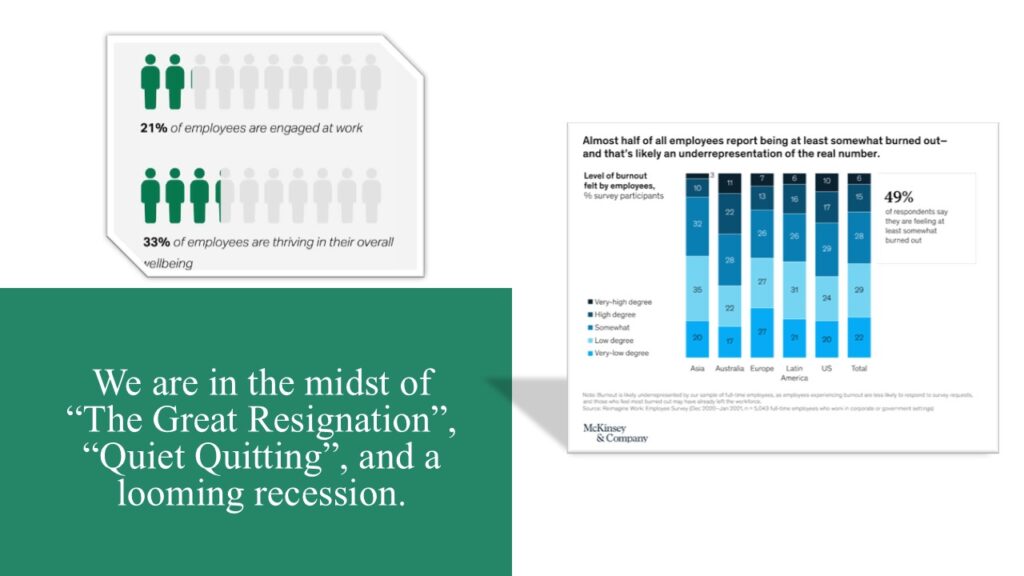You started your business with a vision. An idea that excited you. And then, gradually, you started adding more people to your mission. As your business grew, you created a team. Yet, things are probably not going as smoothly as you want them to be. Being a leader is not easy. And building a high-performing team is more important than ever. Whether you are leading a team of 1 or 10, you want to elevate your leadership skills and learn how to create a team that delivers. Let’s get going, shall we?

The State of the Workforce
The thing is…. You are not alone in facing challenges in your business and when leading your team. You are in good company.
Every year Gallup releases a report about the state of the global workforce. And the picture is not pretty.
Forty-four percent of employees experienced a lot of daily stress in the previous day. And while almost half of the world’s workers felt the burden of stress, working women in the U.S. and Canada region were among the most stressed employees globally.
As you can see below, McKinsey has similar findings, with 49% of employees feeling at least somewhat burned out.
No wonder people are not engaged at work and don’t feel well overall.
And the thing is…
You and your team are most likely also going in and out of the FAST lane – feeling Frustrated, Anxious, Stressed, or Tired most of the time.
“The Great Resignation,” “Quiet Quitting,” and a looming recession – things we constantly hear about in the past few years.
Many men and women are switching jobs for better opportunities or considering leaving the workforce.
So, how do we get out of this situation? What are the keys to building a high-performing team of engaged and fulfilled people?
What would it be like if you and your team were not in the FAST lane?
And how do we make it happen?

Hire The Right Way
It all starts with hiring.
One big mistake we make when hiring is focusing on the knowledge and skill aspects of performance. And we often neglect the mindset and attitude.
Yet, attitude and mindset are way more important. So, one thing you want to ensure is you start hiring for mindset first, knowledge and skills second.
How do you do this?
If you have a team and exemplary employees, list the attributes that make them successful. Are they consistent and hardworking? Or maybe kind and detail-oriented? Or probably outgoing and welcoming?
List 6 to 12 attributes that align with your team and culture. And like with company values it does not really matter which attributes you list. Don’t aim for a laundry list. It’s just important to have a list and then use it to hire the right candidates who exhibit the mindset and attitude you are looking for.
Have you heard the story about Howard Schultz? When asked how Starbucks trained people to be happy he said “We only hire happy people.”
And don’t forget that you don’t just hire people to do a job. You invite them to join a mission. Your job posting should reflect this.
Onboard The Right Way
Once you identify your new team member, the onboarding process is the other key step. Yet, it is another aspect most companies haven’t mastered.
One big mistake with onboarding is focusing only on sharing processes and procedures.
Instead, you want to incorporate the following steps in your onboarding process if you want to have a high-performing and engaged team:
- Show them they belong: create a grand and warm welcoming. Design this step to satisfy our human need of belonging, significance, security, and order.
- Help them gain clarity: show them your way of doing things and have some kind of a scoreboard or personal dashboard that clearly identifies how they will be rewarded for high performance.
- Give them a sense of control: provide them with freedom and autonomy to do the work within the structure you have. You can start with a small circle of control and gradually expand it. After all, as Steve Jobs famously said, you don’t hire smart people to tell them what to do. You hire them to tell you what to do.
- Test them under stress: Character is revealed under stress. Are they entitled, or do they have grit? Have something to test them with an unreasonable timeline and see how they respond. Take them to the catabolic levels and see how they respond naturally. While your interviewing process should be good enough to only accept the best of the best, you never truly know a person’s character until you test them.
- Provide early wins: Help them get small, early wins under their belt. This will boost their confidence and create momentum. We all love seeing progress.
- Praise their success: Recognize at least one visible win for a goal they achieve within the first few weeks or a month. Show it to the whole team. We all love being recognized as well.

Lead the Right Way
Then comes the main part of retaining your top talent.
Here’s where you want to:
- recognize employees regularly
- show appreciation
- encourage and engage them to rise to higher expectations
- compensate well
- even cultivate friendships among your team members
Ultimately, you want to be a Level 6 visionary leader who leads a Level 5 or 6 company.
Level 6 leaders, as per iPEC’s Energy Leadership Framework, are leaders who lead more by presence than by actions. They lead by example and are usually wise, kind, and fair, to name a few.
They are powerful and humble.
They are aware of their excellence and continue growing and getting better every day.
They listen to feedback and take action.
Being a leader is an honor and a responsibility.
Even if you don’t think you are a Level 6 leader, you have it in you. You can become one.
Just the fact that you are here, reading this blog post, illustrates that you are a powerful business leader who is more than capable of building a high-performing team.
Which brings us to the last part of the journey…
Fire the Right Way
… it’s also important to know when to release people from your team. As hard as it is, your role as a business leader is also to know when to let people go.
And this applies the most when you have “bad apples”.
Because attitude is contagious, and even one bad apple spoils the bunch.
In general, you will most likely want to let these people go.
Yet, a big mistake many managers and leaders make is not firing fast enough.
However, you want to do it the right way:
- Pause: Ask yourself whether the person will be surprised if you fire him or her. If the answer is yes, you haven’t kept them accountable.
- Remediate: Develop a 30– to 90-day PIP (performance improvement plan) for underperforming people. If they fit the culture but lack knowledge or a certain skill, it might be possible to help them improve and rise to the occasion.
- Reshuffle: Consider assigning the person a different role within the team. If they have the mindset and skills to be part of your team, maybe a new role is the appropriate next step instead of letting them go.
- Realize: A-players don’t remain A-players forever. Your team will naturally change every few years. As much as we want to keep things constant, change is the only constant in life. It’s OK for people to come and go.
- Release: Create a win-win solution when letting someone go. If the person does not fit in the team anymore, you are doing everyone a favor by releasing them. Your team will benefit, and the person can also grow from there and find a place where they belong and feel fulfilled.
Building a High-Performing Team for Your Business
We covered a lot of steps and ground.
Now, take action!
Don’t let this be another blog post you just read.
Knowledge is not power. Applied knowledge is.
And if you are looking for even more insight into employee engagement in the age of AI and remote work, join our upcoming webinar. Register here now to unleash the power of your team.






